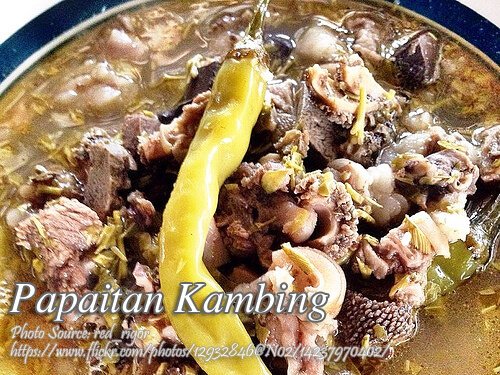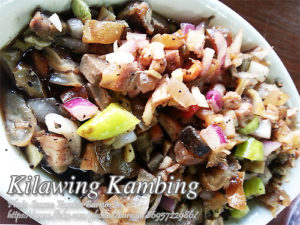Papaitan kambing (or bitter goat stew or goat innard stew) is a popular Ilocano dish composed of goat’s innards such ad tripe, lungs, intestines, kidneys and of course the bile. The bile is used to make the stew bitter but the authentic Ilocano papaitan uses the green enzymes from the small intestines. But if don’t like to use the enzyme you can use the bile instead.
Papaitan Kambing: A Taste of Ilocos Tradition
As a child growing up in Ilocos, few dishes embodied the essence of local fiestas more vividly than papaitan kambing. For special occasions or simple weekend family meals, the bitter goat stew seemed to bring people to the table. My Tito Jun always shares stories about his childhood days and used to assert that papaitan kambing was the recipe that would either ruin or make a good cook. If the sourness was not just right, it would taste either too bland or unbearable sharp. Thank God, he taught me the perfect technique to adjust these flavors. I have so much enthusiasm in sharing this with you.
The Soul of Ilocano Food
The Ilocanos claim one of their most famous dishes comes from the word “pait,” referring to the Ilocano term for bitter. This one dish reeks of history and tradition, typically linked to big family gatherings and celebrations. Traditionally made using goat innards-tripe, lungs, intestines, and kidneys-it is a medley of complex textures. Not to mention, it uses bile or, in authentic versions, green enzymes from the small intestines. It is these ingredients that really define papaitan’s characteristic bitterness.
I remember how my Ate Mila, after coming back from a trip in Vigan, excitedly shared her version of papaitan there. She was amazed at how every bite had a perfect balance of bitterness and tang. According to her, the secret was in how the green enzymes were introduced into the broth-a delicate touch she learned from a local cook. While intimidating to the inexperienced eye, I assure you it’s a process well worth mastering. Once you get it down, you will be whipping up this stew like an authentic Ilocano.
Preparation of Goat Innards
Go through the first step of preparing this dish through the preparation of goat innards. This part may look a little intimidating, but very important in getting the right texture and taste. My Lola Nena always says, “Mas masarap kapag malinis” (It’s tastier when clean), and this dish would not really be one without those words being followed. It is necessary to give all that tripe, lungs, intestines, and kidneys a good wash before cooking.
Once cleaned, you have to parboil the innards. Fifteen minutes of boiling is enough to soften the meat, as well as get rid of unwanted odor. My Tito Jun always insisted that I put crushed ginger and whole garlic in at this stage. “Pampaalis ng lansa,” he would say-it helps neutralize the gamey taste of the goat. This simple technique works wonders and ensures that the final dish is not overly pungent.
A Delicate Balancing Act
With the innards prepped and sliced, it’s finally time to assemble the stew. The best part: getting into the real magic and within the realm of balancing a bitterness-sour scale with accuracy. Begin by sautéing the garlic, onions, and ginger. My cousin Bong, the grand master of Papaitan Kambong, taught me that you have to let the onions be until they are almost soft and caramelizing. This comes out as sweet, which will later mellow down the bitterness.
Once you’ve added innards to the pot, you are going to sauté for a while and also let them start to yield their natural oils and flavor. Of course, patis or fish sauce has to be added as well to provide that depth of umami. From here, you want to add enough water to cover your innards and let it simmer over gentle heat for about an hour. The slow cooking process of innards makes the meat tender and allows the flavors to fall into place.
Achieving the Perfect Bitterness
The final and most important step in making this goat stew is adding the papait, the green enzymes from the small intestines, or bile. This is what gives the dish its special bitter taste. I still remember the first time I made this dish under the watchful eye of my Tito Jun. I was really nervous to be adding too much bitterness, but he told me it’s all about just adding a little at a time and tasting as you go. If you don’t have access to the enzymes, bile is an absolutely acceptable substitute.
There will also be a sharp, acrid aftertaste to balance out that bitterness, something usually available from the tamarind or sinigang mix in many cooks’ renditions. My sister, Nena, prefers the latter because it gives just the right tinge of tartness without overpowering the dish. The combination of bile-bitterness and sinigang mix-tartness works wonderfully in creating a great contrast that takes each spoonful of Papaitan home.
A Stew for the Soul
Papaitan is not your everyday kind of stew because it can be said that it embodies a kind of Ilocano ingenuity in turning even the most banal elements into something wondrous. To me, this dish would always remind me of family gatherings, the words of wisdom passed from generation to generation. My Lola Nena once told me that the bitterness in papaitan kambing mirrors life’s struggles, but the warmth of the stew brings comfort, much like family does. And she was right—each bowl offers a little bit of home and a lot of heart.
So, if you’re a beginner intimidated by the idea of cooking with goat innards, don’t worry. Actually, using the right techniques and showing a little patience will reveal that preparing this dish is more than just following a string of steps-it is embracing the rich culinary history of Ilocos. Next thing you know, you are serving a piping hot bowl of stew and ready to impress your loved ones with the perfect balance of bitterness, sourness, and heartwarming tradition.
How to Cook Papaitan Kambing (Bitter Goat Stew)
Ingredients
- 1 kilo goat innards tripe, lungs, small intestines, kidney
- 1 head whole garlic
- 3 Tbsp. ginger sliced into strips
- 1 inch ginger crushed
- 1 head garlic chopped
- 2 pc red onion chopped
- 1/8 cup spring onion chopped
- 1 small packet plain sinigang mix tamarind
- 3 pcs siling haba green finger chili, sliced
- 1/2 cup patis
- granulated seasoning e.g. Magic Sarap, NamNam to taste (optional)
- salt and pepper to taste
Instructions
How to Cook Papaitan Kambing:
- Wash the goat's tripe, lungs, small intestines and kidneys thoroughly and set aside the intestines.
- In a medium size pot put the tripe, lungs, kidneys, whole garlic and crushed ginger with enough water just to cover the meat.
- Boil for at least 15 minutes then drain. Let is cool and set aside.
- In another pot, put the small intestines and fill with water just enough to cover the intestines.
- Boil for at least 15 minutes then drain the intestines and set aside to cool. Save the green liquid from the boiled intestines which you will use later as papait.
- Slice all the goat innards into tidbits. In a small pan saute garlic until fragrant then follow the onions and ginger and saute until the onions are soft.
- Add the goat innards and saute for about 9 minutes or until the innards starts to produce oil.
- Pour some fish sauce or patis and stir for 4 minutes then pour water just enough to cover the innards. Simmer for at least 1 hour or less or until the meat is tender. Add water if the liquid is evaporating too much.
- Last but not the least add the siling haba, sinigang mix and the papait (the green enzyme).
- Add the sinigang mix and the papait a little at a time until the desired bitterness and sourness is achieved.
- Simmer for another 4 to 5 minutes and season with salt, pepper and granulated seasoning. Serve hot with steamed rice.
Notes
Cooking Tips to Prepare Perfect Papaitan Kambing
Cooking papaitan kambing is such a pleasure, yet demands precision and care to get that perfect blend of flavors. Following are three useful cooking tips to ensure that your papaitan kambing is simply the best and authentic as can be:Clean and Prepare the Innards Thoroughly
Clean and ready the innards of a goat very well before you start cooking. Make sure to clean the tripe, lungs, small intestines, and kidneys properly. This will ensure that you have removed all dirt and impurities that may bring unwanted odors along. It further helps in producing a cleaner, more authentic flavor. Chop the innards into small tidbits after cleaning in order to ensure they cook evenly.Levels of Bitterness
The bitter nature of papaitan kambing has been presented in its uniqueness. To impart the right bitter and sour tastes, it should be added gradually. This comes in during the addition of the bitter component, which may either be bile or green enzymes. Start with a small quantity, taste, then add more if necessary. This will help find just the right bitterness level to your preference. Remember that it is easier to add more bitterness and otherwise impossible to remove excess bitterness.Patience for Tender Meat
Papaitan kambing best tastes when innards are soft and juicy, so let the innards be cooked for a long time. Be patient and let it slowly tender while cooking. It usually takes at least an hour or up to more for innards to tenderize. In case you see liquid evaporating too quick, you may also add water if you want the liquid to remain as intended and avoid overcooking.






How can I fix the soup if I added too much of the Bile😩😔
Hi Nicole, I think adding a little more water and a small amount of sugar will help.
Thanks for this papaitan recipe. You are very creative using an alternative “papait”. I didn’t know that you can use ampalaya leaves as an alternative. I will definitely try this recipe!
Hi Carolina, yes ampalaya leaves can be used as an alternative because it is very bitter.
Healthier too than intestinal organs!